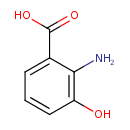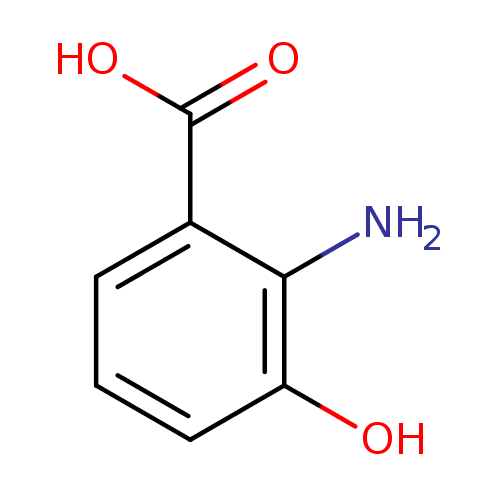|
Record Information |
|---|
| Version |
1.0 |
|---|
| Update Date |
1/22/2018 11:54:54 AM |
|---|
|
Metabolite ID | PAMDB110183 |
|---|
|
Identification |
|---|
| Name: |
3-hydroxyanthranilate |
|---|
| Description: | A hydroxybenzoate that is the conjugate base of 3-hydroxyanthranilic acid. |
|---|
|
Structure |
|
|---|
| Synonyms: | -
3-hydroxyanthranilic acid
-
2-amino-3-hydroxybenzoate
|
|---|
|
Chemical Formula: |
C7H6NO3
|
|---|
| Average Molecular Weight: |
152.13 |
|---|
| Monoisotopic Molecular
Weight: |
153.0425930962 |
|---|
| InChI Key: |
WJXSWCUQABXPFS-UHFFFAOYSA-M |
|---|
| InChI: |
InChI=1S/C7H7NO3/c8-6-4(7(10)11)2-1-3-5(6)9/h1-3,9H,8H2,(H,10,11)/p-1 |
|---|
| CAS
number: |
548-93-6 |
|---|
| IUPAC Name: | 2-amino-3-hydroxybenzoate |
|---|
|
Traditional IUPAC Name: |
3-hydroxyanthranilic acid |
|---|
| SMILES: | C1(C=C(C(N)=C(O)C=1)C([O-])=O) |
|---|
|
Chemical Taxonomy |
|---|
|
Taxonomy Description | This compound belongs to the class of chemical entities known as hydroxybenzoic acid derivatives. These are compounds containing a hydroxybenzoic acid (or a derivative), which is a benzene ring bearing a carboxyl and a hydroxyl groups. |
|---|
|
Kingdom |
Chemical entities |
|---|
| Super Class | Organic compounds |
|---|
|
Class |
Benzenoids |
|---|
| Sub Class | Benzene and substituted derivatives |
|---|
|
Direct Parent |
Hydroxybenzoic acid derivatives |
|---|
| Alternative Parents |
|
|---|
| Substituents |
- Aminobenzoic acid
- Aminobenzoic acid or derivatives
- Hydroxybenzoic acid
- Benzoic acid
- O-aminophenol
- Aminophenol
- Benzoyl
- Aniline or substituted anilines
- 1-hydroxy-4-unsubstituted benzenoid
- 1-hydroxy-2-unsubstituted benzenoid
- Phenol
- Primary aromatic amine
- Vinylogous amide
- Amino acid
- Amino acid or derivatives
- Carboxylic acid derivative
- Carboxylic acid
- Monocarboxylic acid or derivatives
- Primary amine
- Hydrocarbon derivative
- Organopnictogen compound
- Organic oxygen compound
- Organooxygen compound
- Amine
- Organic oxide
- Organic nitrogen compound
- Organonitrogen compound
- Aromatic homomonocyclic compound
|
|---|
| Molecular Framework |
Aromatic homomonocyclic compounds |
|---|
| External Descriptors |
|
|---|
|
Physical Properties |
|---|
| State: |
Solid |
|---|
| Charge: | -1 |
|---|
|
Melting point: |
Not Available |
|---|
| Experimental Properties: |
| Property | Value | Reference |
|---|
| Melting Point | Not Available | Not Available | | Boiling Point | Not Available | Not Available | | Water Solubility | Not Available | Not Available | | LogP | Not Available | Not Available |
|
|---|
| Predicted Properties |
|
|---|
|
Biological Properties |
|---|
| Cellular Locations: |
Not Available |
|---|
| Reactions: | |
|---|
|
Pathways: |
|
|---|
|
Spectra |
|---|
| Spectra: |
| Spectrum Type | Description | Splash Key | |
|---|
| GC-MS | GC-MS Spectrum - GC-EI-TOF (Pegasus III TOF-MS system, Leco; GC 6890, Agilent Technologies) | splash10-0zfv-0945000000-e3389ab25b7133eb184d | View in MoNA |
|---|
| GC-MS | GC-MS Spectrum - GC-MS (3 TMS) | splash10-0zfu-1955000000-fd51cc45bf09750e2b48 | View in MoNA |
|---|
| Predicted GC-MS | Predicted GC-MS Spectrum - GC-MS | Not Available |
|---|
| LC-MS/MS | LC-MS/MS Spectrum - Quattro_QQQ 10V, Positive (Annotated) | splash10-000i-0900000000-2313e347dd8659099393 | View in MoNA |
|---|
| LC-MS/MS | LC-MS/MS Spectrum - Quattro_QQQ 25V, Positive (Annotated) | splash10-001i-9400000000-4e342fdebc8145b606a1 | View in MoNA |
|---|
| LC-MS/MS | LC-MS/MS Spectrum - Quattro_QQQ 40V, Positive (Annotated) | splash10-001i-9000000000-ee5255b437ae762be1f9 | View in MoNA |
|---|
| Predicted LC-MS/MS | Predicted LC-MS/MS Spectrum - 10V, Positive | Not Available |
|---|
| Predicted LC-MS/MS | Predicted LC-MS/MS Spectrum - 20V, Positive | Not Available |
|---|
| Predicted LC-MS/MS | Predicted LC-MS/MS Spectrum - 40V, Positive | Not Available |
|---|
| Predicted LC-MS/MS | Predicted LC-MS/MS Spectrum - 10V, Negative | Not Available |
|---|
| Predicted LC-MS/MS | Predicted LC-MS/MS Spectrum - 20V, Negative | Not Available |
|---|
| Predicted LC-MS/MS | Predicted LC-MS/MS Spectrum - 40V, Negative | Not Available |
|---|
| 1D NMR | 1H NMR Spectrum | Not Available |
|---|
| 1D NMR | 1H NMR Spectrum | Not Available |
|---|
| 1D NMR | 13C NMR Spectrum | Not Available |
|---|
| 1D NMR | 1H NMR Spectrum | Not Available |
|---|
| 1D NMR | 13C NMR Spectrum | Not Available |
|---|
| 2D NMR | [1H,13C] 2D NMR Spectrum | Not Available |
|---|
|
|---|
|
References |
|---|
| References: |
- De Antoni A, Rubaltelli FF, Costa C, Allegri G: Effect of phototherapy on the urinary excretion of tryptophan metabolites in neonatal hyperbilirubinemia. Acta Vitaminol Enzymol. 1975;29(1-6):145-50. [1244083 ]
- Calandra P: Research on tryptophan metabolites "via kynurenine" in epidermis of man and mouse. Acta Vitaminol Enzymol. 1975;29(1-6):158-60. [1244085 ]
- Hegedus ZL, Frank HA, Altschule MD, Nayak U: Human plasma lipofuscin melanins formed from tryptophan metabolites. Arch Int Physiol Biochim. 1986 Dec;94(5):339-48. [2440410 ]
- Werner ER, Lutz H, Fuchs D, Hausen A, Huber C, Niederwieser D, Pfleiderer W, Reibnegger G, Troppmair J, Wachter H: Identification of 3-hydroxyanthranilic acid in mixed lymphocyte cultures. Biol Chem Hoppe Seyler. 1985 Jan;366(1):99-102. [3159398 ]
- Teulings FA, Mulder-Kooy GE, Peters HA, Fokkens W, Van Der Werf-Messing B: The excretion of 3-hydroxyanthranilic acid in patients with bladder and kidney carcinoma. Acta Vitaminol Enzymol. 1975;29(1-6):108-12. [1244078 ]
- Lopez AS, Alegre E, LeMaoult J, Carosella E, Gonzalez A: Regulatory role of tryptophan degradation pathway in HLA-G expression by human monocyte-derived dendritic cells. Mol Immunol. 2006 Jul;43(14):2151-60. Epub 2006 Feb 21. [16490253 ]
- Yeh JK, Brown RR: Effects of vitamin B-6 deficiency and tryptophan loading on urinary excretion of tryptophan metabolites in mammals. J Nutr. 1977 Feb;107(2):261-71. [833687 ]
- Herve C, Beyne P, Jamault H, Delacoux E: Determination of tryptophan and its kynurenine pathway metabolites in human serum by high-performance liquid chromatography with simultaneous ultraviolet and fluorimetric detection. J Chromatogr B Biomed Appl. 1996 Jan 12;675(1):157-61. [8634758 ]
- Teulings FA, Lems PH, Portengen H, Henkelman MS, Blonk DI: The action of 3-hydroxyanthranilic acid and other tryptophan metabolites on stimulated human lymphocytes. Acta Vitaminol Enzymol. 1975;29(1-6):113-6. [1244079 ]
|
|---|
| Synthesis Reference: |
Warnell, J. L. 3-Hydroxyanthranilic acid. Biochemical Preparations (1958), 6 20-4. |
|---|
| Material Safety Data Sheet (MSDS) |
Download (PDF) |
|---|
|
Links |
|---|
| External Links: |
|
|---|


